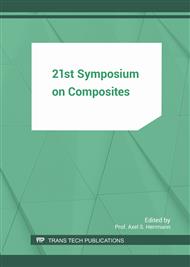p.427
p.434
p.440
p.447
p.457
p.463
p.473
p.482
p.490
Wetting Behavior of Carbon Fibers: Influence of Surface Activation and Sizing Type
Abstract:
To investigate the wetting behavior of unsized carbon fibers with a sizing dispersion and the wettability of sized fibers with the liquid polymeric resin, contact angle measurements by capillary rise experiments are performed by tensiometry. First, the sizing behavior of fibers with different degrees of surface activation is analyzed. Increasing activation levels result in increasing oxygen surface concentrations and accordingly increasing polar components of the surface energies. These conditions result in a better wettability of the higher activated fibers. Secondly, the influence of the type of sizing dispersion is addressed by using two water-based epoxy sizing dispersions, i.e. a standard epoxy sizing and an advanced functional epoxy sizing with high reactivity. Using the functional sizing the wettability is further improved. Finally, the influence of the sizing on the wettability of the carbon fibers by the matrix polymer during resin infiltration is investigated using the differently sized fibers and a liquid epoxy resin. Carbon fibers with functional sizing show improved wettability by the resin compared to fibers with standard sizing. The results show that the wetting behavior of carbon fibers with respect to sizing and polymer matrix can be controlled by a suitable choice of surface activation of the fibers and reactivity of the polymeric sizing dispersion.
Info:
Periodical:
Pages:
457-462
Citation:
Online since:
July 2017
Keywords:
Price:
Сopyright:
© 2017 Trans Tech Publications Ltd. All Rights Reserved
Share:
Citation:


